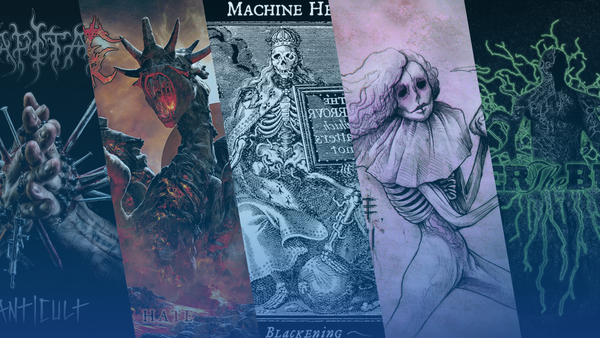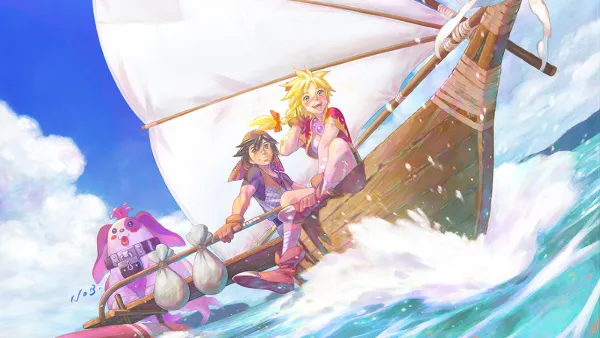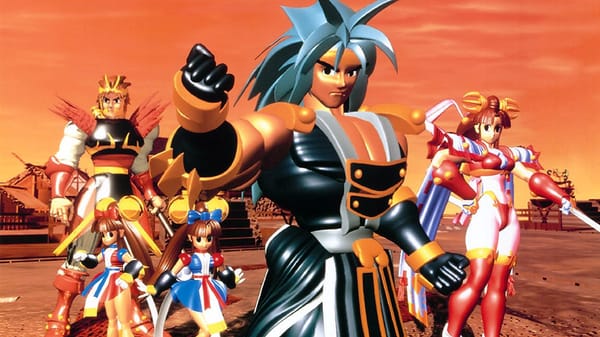M.U.S.H.A. | A Cyber-Samurai Shoot-out
Do you love: Robots? Samurai? Blasting things to bits? If you said "yes" to any of these, you're in for a treat.
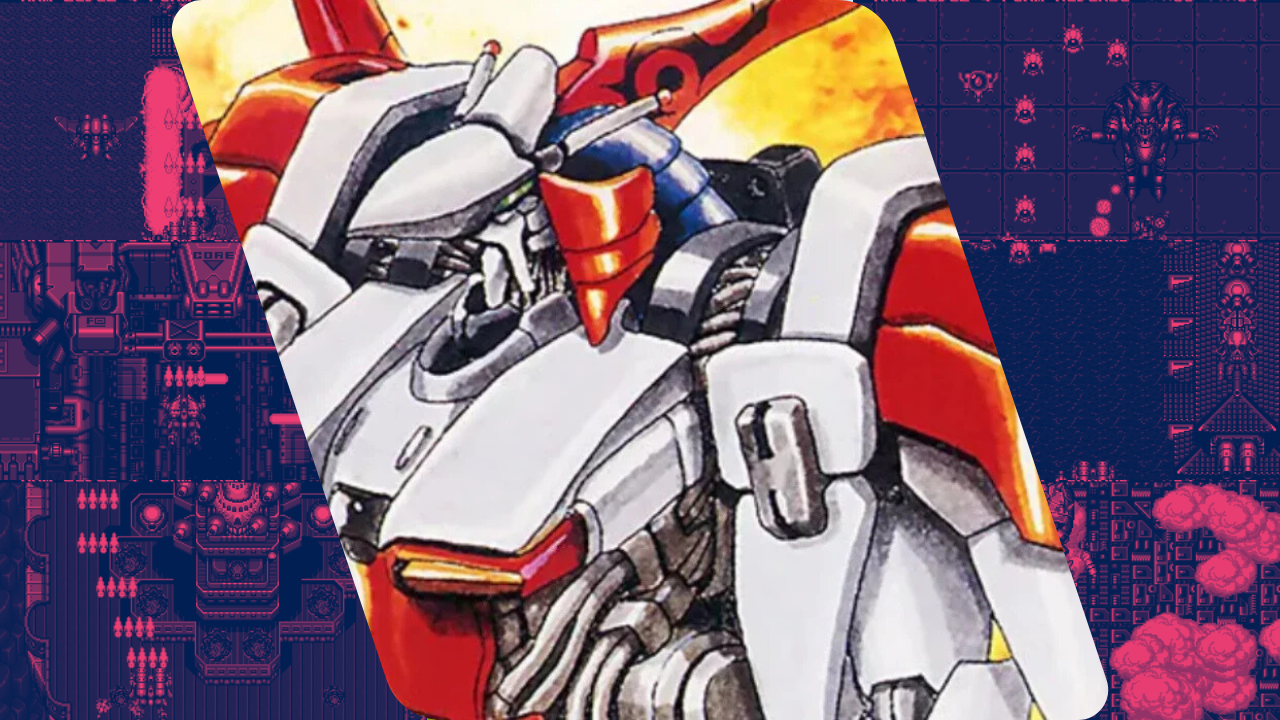
The Sega Genesis was to shoot-em-ups what the SNES was to RPGs. Due to its faster processing speed, the Genesis (or Mega Drive as it’s known outside of North America) typically ran shooters better than the SNES, and Sega took full advantage of that. With such a gigantic library of shmups, it may be difficult to figure out which one to start with. You’ve got Steel Empire, Thunder Force 3 and 4, Elemental Master, and even Gaiares just to name a handful of the best on the system. But if I was to recommend any one shooter, whether it be to a shmup veteran or newbie, it would have to be M.U.S.H.A. Released as a Genesis exclusive in 1991 in North America, I didn’t know anything about this game until it was released on Nintendo Switch Online’s Genesis library in 2021.
While the Genesis is pretty inundated with shmups, there is a lot that sets this game apart from its bullet hell brethren. By the end of this article, I hope you end up checking it out and enjoying it as much as I do. Admittedly, I’m still a bit new to shmups. I’ve been getting more and more into them as I’ve dove into the Arcade Archives releases on Switch, and even more now that I’ve been digging through so many retro libraries on my Anbernic. I’m started to get more and more addicted to the genre as I go, with M.U.S.H.A. being my latest obsession.
Let’s hop in and check this game out.
Visuals
While M.U.S.H.A. is the third game released in the Aleste series, it trades the “spaceship in space” aesthetic for a sweet Japanese style, featuring lots of Japanese architecture, bosses resembling demons from Japanese folklore, and the player piloting a samurai-like mechsuit.
The game shares its basic mechanics with previous Aleste games but drastically reinvents the setting with the player piloting a large flying mecha in futuristic environments evoking feudal Japan. The word "musha" (武者) means "warrior" or "samurai" and signifies this aesthetic.
Source: https://segaretro.org/M.U.S.H.A.
If there’s one thing that I love about the 16-bit generation, it’s the amount of detail that artists were able to squeeze out of the hardware. Each stage feels so unique due to the incredible amount of depth and color used (except the last 3 stages, which feel like one very long stage). M.U.S.H.A. is littered with cool, small details, like rickety rope bridges going across a chasm, or the stage 1 boss leaving behind huge tracks as it runs over and smashes everything with its caterpillar tracks.
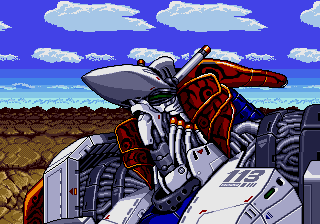

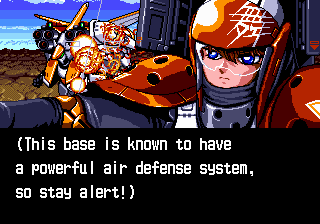
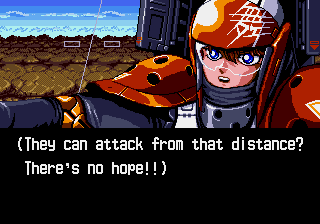
The opening video to the game has an undeniable 90s anime feel, with an amazing amount of detail in not only the pilot’s design, but also the close-ups of the mechsuit, and the environment seen outside of the mechsuit. You even get to see what it’s like in the cockpit of the mechsuit, with various holographic overlays and the many tubes and cables connected to the seat in the cockpit.
The environments are incredibe for a Genesis game. Quite a few stages use parallax scrolling and feature many layers underneath the player character to make you feel like you’re flying stories above the ground level. Stage 3 in particular has you flying through a giant chasm, with rocky ridges lining each side of the screen, with the very bottom of the chasm housing a river of lava.
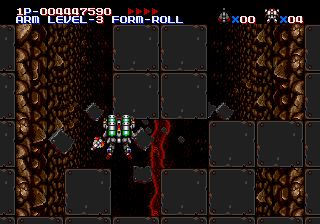
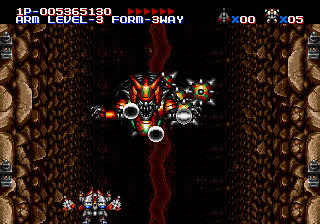
A few screenshots from Stage 3 of MUSHA
One of my favorite stages was stage 4. Toward the beginning you’ll see lots of dark, swirling storm clouds and bright lightning strikes. As you fly along, you’ll sometimes spot ninja robots hiding beneath the clouds, and then they’ll suddenly jump out and attack you. As you get toward the end of the stage, the storm subsides. But you see lots of light clouds passing by as you fly over a technologically advanced city, resembling a microchip more than it does a city. You’ll see this kind of thing a lot in this game.
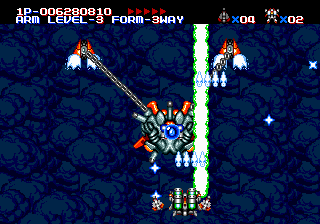
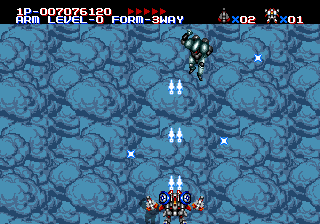
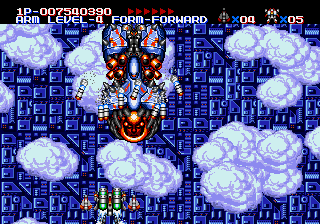
Gameplay
M.U.S.H.A. is a vertical shooter, with gameplay pretty similar to others in the genre. Your main weapon can be upgraded by collecting power chips, starting with a burst-fire gun and gradually gaining more projectiles, faster rate of fire, and more. Every 3 power chips collected grants you an option, which is essentially a drone that flies near you and fires with you. Additionally, options can be set to one of the following firing patterns:
- Forward: options fire ahead of you for maximum single target damage.
- 3-Way: options fire at a 45-degree angle, giving you more spread.
- Back: options fire behind you, in case of enemies coming from behind.
- Reverse: options fire opposite of the last direction pressed (if you press left, they’ll fire right, etc.)
- Roll: options continuously revolve around you, firing in as they go.
- Free: option will act autonomously, attacking anything nearby.
Each of these firing patterns can be immensely helpful, depending on your playstyle. I normally stick with forward, but free and reverse are very helpful for those bosses that take up a huge chunk of the screen and keep you trapped to one side. I found roll to be very helpful when there’s entirely too many enemies on screen. I really like how M.U.S.H.A. lets you play how you want and gives you the tools to craft your perfect playstyle.
Alongside all of that is your sub-weapon. While there are only 3 sub-weapons, each one can be upgraded as you collect more of the same sub-weapon that you’re currently using. Additionally, your sub-weapon can be fired alongside your main weapon simultaneously, except for the Defensive detonator, which continuously revolves around you, destroying anything it touches. If you get hit while carrying a sub-weapon, you’ll lose your sub-weapon, acting almost like armor. If you get hit without a sub-weapon, you die and lose a life.

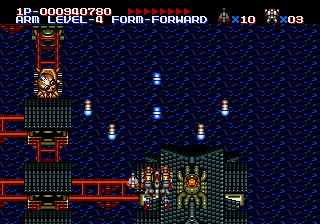
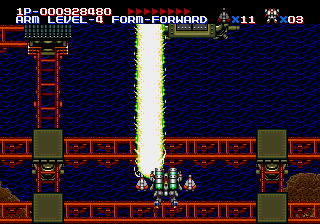
From left to right: Defensive Detonator, Vanishing Buster, Blazing Beam. Source: https://segaretro.org/M.U.S.H.A.
The three sub-weapons are:
- Defensive Detonator: continuously revolves around you, destroying anything it touches (enemies and certain projectiles).
- Vanishing Buster: shoots bombs that explode into area damage.
- Blazing Beam: fires a beam that pierces through enemies.
When both your main and sub-weapon are fully upgraded, you feel like an unstoppable death machine. It sucks to lose your sub-weapon when you take a hit, but that saves you a life and thankfully it doesn’t take too long to get back to your fully upgraded glory.
Another awesome thing that M.U.S.H.A. does that you don’t see in a lot of other shmups is the continue option on the start screen. When running out of lives on most shmups of the time, you would have to start all over from the beginning of the game. But in M.U.S.H.A., you can select Continue on the main menu and play through the last stage that you were at. You’ll have to start from the beginning of that stage, but that’s better than having to start the entire game all over. You also have the option of increasing or decreasing the gameplay speed.
All-in-all, this game feels great to play. Even with the speed set toward the middle, the pacing feels breakneck and maneuvering feels snappy and responsive.
Music
A good video game soundtrack is everything to me. Having both great gameplay and a tight as hell soundtrack is the perfect package, espescially for a shmup—nothing gets your blood pumping than a killer soundtrack while bobbing and weaving around millions of bullets. Luckily for us, M.U.S.H.A.’s soundtrack is influenced heavily by speed metal, which greatly matches the supersonic pacing of the game.
The track for stage 1: “Fullmetal Fighter”.
Right as you start stage 1, your ears are pummeled by this barrage of drums and guitars, immediately kicking you into turbo-drive. The bass in this song is guaranteed to keep your head bobbing long after you’ve beaten that stage.
The track for stage 6: “Offensive Overdrive”.
Stage 6 was one of the hardest for me, but this track was so worth it. Every single time I got a game over, I’d immediately hop right back and hum along to the beginning riff.
The composer, Toshiaki Sakoda, has such an amazing portfolio of soundtracks under his belt. With games like Alien Crush, Devil’s Crush, Seirei Senshi Spriggan (another awesome shooter), and even Treasure Hunter G (really great SNES soundtrack), he just about deserves the title of “Shmup Soundtrack King”.
Thanks for reading ScabStack! If you liked this article, share it with your friends!
Overall
This game kicks ass. It’s a little on the short side, but that’s hardly a negative. The gameplay is slick, allows for a lot of customization, and newcomer-friendly. Also, the soundtrack SLAPS.
If you’re looking for a new shooter on the Sega Genesis, go play M.U.S.H.A.
Thanks for reading ScabStack! If you enjoy my ranting and raving, subscribe for more!

